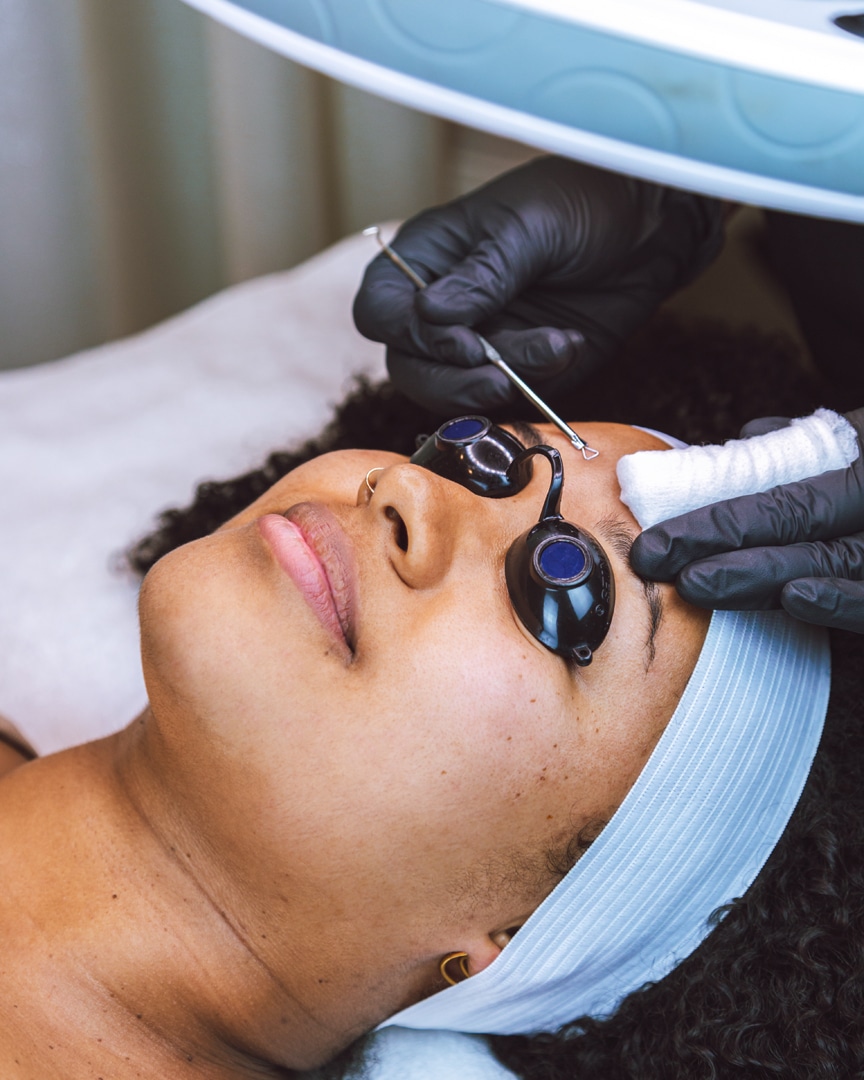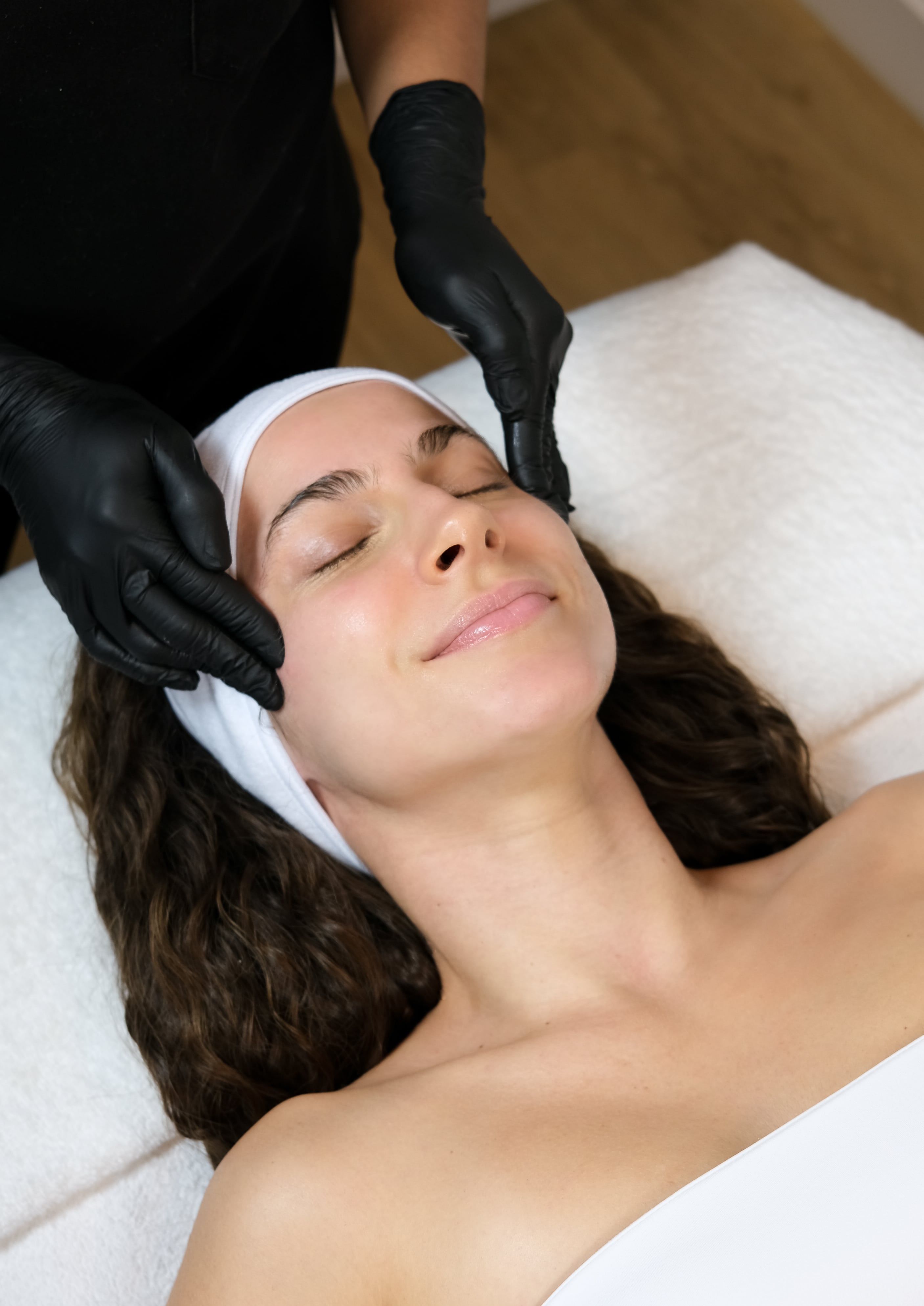Breakouts can be frustrating enough, but even after active acne is gone, it’s common to be left with scars that can be difficult to get rid of. Those uneven textures, dark spots, or pitted marks can feel like stubborn reminders of the struggle you’ve already fought. If you’ve ever felt like your skin just won’t bounce back, you’re not alone.
Acne scars are incredibly common and, thankfully, treatable. With the right professional care and consistent skincare routine, smoother, more even-toned skin is absolutely possible. But before diving into treatments, it’s important to understand what acne scars are and why they form.
Not every mark left behind after acne is a true scar. Some are temporary discolorations – red or brown spots known as post-inflammatory erythema (PIE) or hyperpigmentation (PIH) – while others are true scars in the skin caused by damage to deeper layers. Knowing the difference helps you find the best acne scar treatment for your skin.
In this blog, we’ll break down what causes acne scars, the different types, and the most effective ways to treat them. We’ll also explore how Silver Mirror’s advanced facial treatments can help resurface and renew post-acne skin, delivering visible and lasting improvement.
Our estheticians specialize in customized, results-driven treatments that smooth, brighten, and rebuild your skin’s natural glow so you can finally feel confident in your complexion again.
What Causes Acne Scars?
Acne scars are lasting changes to your skin’s texture and tone caused by inflammation during breakouts. When a blemish, especially a deep cyst or nodule, penetrates far into the skin, it damages tissue that the body then tries to repair. Sometimes, this repair process doesn’t go perfectly, resulting in either a loss of tissue (skin divots) or an overproduction of collagen (raised scars).
Scarring tends to happen when:
- Breakouts are picked or popped. Picking disrupts the skin’s healing process and drives inflammation deeper
- Inflammation is prolonged. The longer acne remains untreated, the more tissue damage occurs
- There’s a genetic tendency. Some people naturally produce less collagen or have more reactive skin that scars more easily
- Collagen breakdown occurs. Inflammation weakens collagen, the structural protein that gives skin its firmness, making it harder for skin to repair evenly
While acne scars can be frustrating, prevention starts with early acne treatment and minimizing trauma to the skin. Treating breakouts quickly, avoiding picking, and supporting your skin’s natural healing process all help reduce the likelihood of long-term scarring.
Types of Acne Scars
Not all acne scars are created equal. Understanding which type you have is the key to choosing the most effective treatment plan. Here’s a closer look at the most common categories:
1. Atrophic Scars (Depressed or Indented Scars)
These are the most common type of acne scars. They occur when the skin loses tissue during the healing process, leaving behind indentations.
Subtypes include:
- Ice Pick Scars: Deep, narrow pits that resemble tiny punctures or holes. These are often the hardest to treat because they extend deep into the dermis.
- Boxcar Scars: Wider depressions with sharp edges, often found on the cheeks and temples.
- Rolling Scars: Shallow, wave-like indentations with sloping edges that create uneven skin texture.
2. Hypertrophic and Keloid Scars
These raised scars are caused by an overproduction of collagen during the healing process.
- Hypertrophic scars stay within the boundaries of the original acne lesion
- Keloid scars extend beyond the original site and can continue to grow
They’re more common on the chest, shoulders, jawline, and back. These scars can feel firm or rubbery and may appear pink, red, or darker than the surrounding skin.
3. Post-Inflammatory Hyperpigmentation (PIH)
PIH appears as flat, dark spots that remain after a pimple heals. While technically not a “true” scar, they’re often grouped with acne scars because they can persist for months. PIH occurs when inflammation triggers excess melanin production. It’s especially common in medium to deeper skin tones.
4. Post-Inflammatory Erythema (PIE)
PIE shows up as lingering red or pink marks caused by damaged capillaries after inflammation. Common in lighter skin tones, these marks can take months to fade on their own.
Whether your post-acne marks are indented, raised, or discolored, understanding their root cause helps determine the best course of treatment, and that’s where professional care makes a world of difference.
Effective Acne Scar Treatments
Treating acne scars requires patience and precision. The best results come from a combination of professional treatments and consistent at-home care, tailored to your specific scar type, skin tone, and sensitivity level.
Below are some of the most effective acne scar treatments available today.
Exfoliating and Resurfacing Treatments
These treatments focus on removing damaged surface layers of skin to smooth texture and even out tone.
Chemical Peels
Chemical peels use ingredients like glycolic, lactic, or salicylic acid to exfoliate dead cells and stimulate new skin growth. Peels can fade discoloration, refine pores, and soften shallow scars over time.
Enzyme Exfoliation
For sensitive skin or mild scarring, enzyme-based exfoliation is a gentler way to resurface and brighten skin compared to an acid or physical exfoliant. These treatments use natural enzymes (often from fruits like papaya or pumpkin) to dissolve dead skin without irritation.
Hydradermabrasion
This non-invasive exfoliation technique buffs away surface irregularities, improving skin tone and texture while promoting collagen production. It’s ideal for mild acne scars and dull, uneven skin.
Collagen-Stimulating Treatments
Because acne scars often result from collagen loss, stimulating your skin to produce more is key to smoother, firmer texture.
LED Light Therapy
LED therapy, especially red and infrared light, encourages healing and collagen synthesis while reducing inflammation. Over time, this helps smooth depressions and improve skin tone.
Microchanneling
Microneedling creates controlled micro-injuries in the skin, triggering the body’s repair response and boosting collagen and elastin production. It’s particularly effective for rolling and boxcar scars.
Targeted Skincare Ingredients
Daily skincare plays a crucial role in maintaining and enhancing professional results.
Retinoids – Accelerate cell turnover, improve uneven texture, and fade discoloration.
Vitamin C – Brightens dark spots and supports collagen synthesis.
Niacinamide – Reduces redness, strengthens the skin barrier, and refines pores.
Alpha & Beta Hydroxy Acids (AHAs & BHAs) – Smooth roughness, prevent clogged pores, and enhance overall radiance.
Sun Protection
No acne scar treatment is complete without sunscreen. UV exposure can darken scars and delay healing. Daily SPF helps prevent hyperpigmentation from worsening and protects your skin’s progress after professional treatments.
How Silver Mirror Treats Acne Scars
At Silver Mirror Facial Bar, we understand that no two skin journeys are alike. Our estheticians take a customized approach to every treatment, focusing on resurfacing, renewal, and restoring your skin’s natural smoothness.
Here’s how we help you achieve visible, long-term improvement:
Customized Acne-Focused Facials
Each facial combines exfoliation, hydration, and targeted treatments tailored to your unique skin. Our estheticians select the right combination of masks, enzymes, and actives to fade discoloration and refine uneven texture.
LED Light Therapy
Reduces inflammation, calms redness, and supports collagen repair, helping the skin rebuild from within.
Chemical or Enzyme Peels
Our professional peels are chosen based on your skin type and sensitivity. They help lighten dark marks, resurface rough patches, and reveal a brighter, smoother complexion.
Professional Extractions
Careful, hygienic extractions prevent new breakouts that could lead to additional scarring, keeping your skin clear as it heals.
At-Home Product Recommendations
After each treatment, your esthetician creates a customized skincare routine featuring brightening, resurfacing, and barrier-supporting ingredients to maintain and enhance your in-office results.
Every Silver Mirror facial is completely personalized. We assess your scar type, skin condition, and goals to create a plan that works because healing looks different for everyone.
Healing Takes Time (But It’s Worth It)
When it comes to acne scar treatment, patience pays off. Skin repair and collagen regeneration are gradual processes, meaning noticeable changes develop over weeks and months – not days.
While a single treatment can leave your skin looking refreshed, lasting results typically come from a consistent series of sessions paired with a dedicated home routine. Over time, scars soften, discoloration fades, and your skin’s overall texture becomes smoother and more radiant.
The key is consistency. Each facial and product builds on the progress of the last, helping your skin rebuild strength and resilience. Even subtle improvements, like smoother light reflection or fewer visible shadows, can dramatically boost your confidence.
At Silver Mirror, our estheticians are your partners throughout this journey. We guide you every step of the way, adjusting treatments as your skin evolves to ensure safe, effective, and long-lasting results.
Transform Your Post-Acne Skin with Customized Facials From Silver Mirror
Acne scars don’t have to be permanent. With the right professional treatments and expert care, you can dramatically improve your skin’s tone, texture, and overall health.
At Silver Mirror, we specialize in both acne management and post-acne rejuvenation. Every treatment plan is customized to your skin type, sensitivity, and goals, helping you achieve visible results that last. Because healing isn’t just about treating scars, it’s about restoring your confidence and helping you love the skin you’re in.
Book your customized facial at Silver Mirror today and start your skin renewal journey.
By



